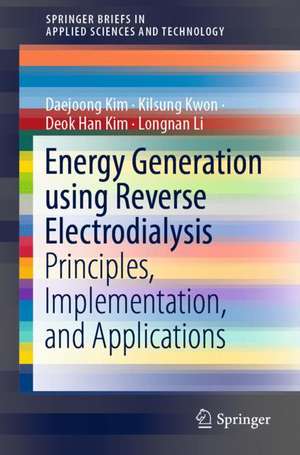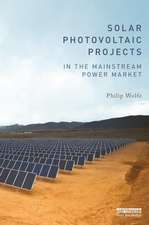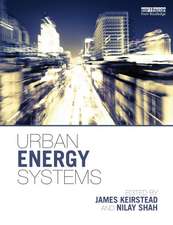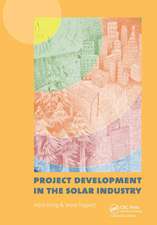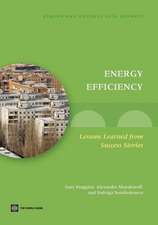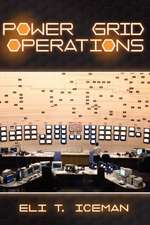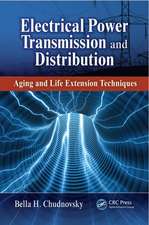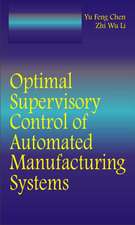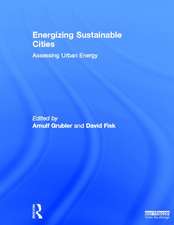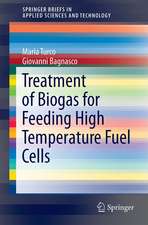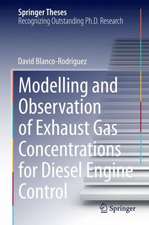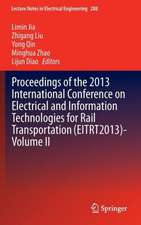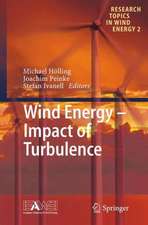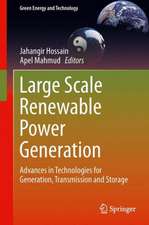Energy Generation using Reverse Electrodialysis: Principles, Implementation, and Applications: SpringerBriefs in Applied Sciences and Technology
Autor Daejoong Kim, Kilsung Kwon, Deok Han Kim, Longnan Lien Limba Engleză Paperback – 2 mai 2019
Salinity gradient energy (SGE) has received significant attention recently due to the energy crisis resulting from the depletion of fossil fuels and the growth in energy demand. There are currently three methods to convert SGE into electricity: pressure retarded osmosis (PRO), reverse electrodialysis (RED), and capacitive mixing (CAPMIX). This book covers the theory and implementation of reverse electrodialysis, which uses ion exchange membranes to selectively deliver cations or anions, and its advantages over other methods, such as high reliability without any moving parts, the direct energy conversion process from chemical energy to electrical energy, and its low fouling rate. All of these have made RED an attractive option, however, there are various challenges in the route to commercialization and these are also described.
The book summarizes the research progress and current status of RED, with a final chapter considering the outlook for the future of the technology at a commercial level.
Din seria SpringerBriefs in Applied Sciences and Technology
-
 Preț: 380.29 lei
Preț: 380.29 lei - 17%
 Preț: 360.34 lei
Preț: 360.34 lei - 20%
 Preț: 386.12 lei
Preț: 386.12 lei -
 Preț: 380.07 lei
Preț: 380.07 lei -
 Preț: 377.95 lei
Preț: 377.95 lei -
 Preț: 382.32 lei
Preț: 382.32 lei -
 Preț: 376.59 lei
Preț: 376.59 lei -
 Preț: 379.09 lei
Preț: 379.09 lei -
 Preț: 378.12 lei
Preț: 378.12 lei - 20%
 Preț: 293.83 lei
Preț: 293.83 lei -
 Preț: 344.90 lei
Preț: 344.90 lei -
 Preț: 321.36 lei
Preț: 321.36 lei -
 Preț: 264.79 lei
Preț: 264.79 lei -
 Preț: 344.90 lei
Preț: 344.90 lei -
 Preț: 356.46 lei
Preț: 356.46 lei -
 Preț: 382.95 lei
Preț: 382.95 lei -
 Preț: 355.66 lei
Preț: 355.66 lei -
 Preț: 479.67 lei
Preț: 479.67 lei -
 Preț: 415.18 lei
Preț: 415.18 lei -
 Preț: 444.52 lei
Preț: 444.52 lei - 20%
 Preț: 301.86 lei
Preț: 301.86 lei -
 Preț: 409.43 lei
Preț: 409.43 lei - 20%
 Preț: 322.17 lei
Preț: 322.17 lei -
 Preț: 355.49 lei
Preț: 355.49 lei - 15%
 Preț: 462.51 lei
Preț: 462.51 lei -
 Preț: 377.18 lei
Preț: 377.18 lei -
 Preț: 355.93 lei
Preț: 355.93 lei -
 Preț: 382.95 lei
Preț: 382.95 lei -
 Preț: 378.12 lei
Preț: 378.12 lei -
 Preț: 378.12 lei
Preț: 378.12 lei -
 Preț: 380.07 lei
Preț: 380.07 lei -
 Preț: 380.07 lei
Preț: 380.07 lei - 20%
 Preț: 326.28 lei
Preț: 326.28 lei -
 Preț: 312.68 lei
Preț: 312.68 lei -
 Preț: 356.43 lei
Preț: 356.43 lei -
 Preț: 412.30 lei
Preț: 412.30 lei - 20%
 Preț: 225.31 lei
Preț: 225.31 lei -
 Preț: 378.12 lei
Preț: 378.12 lei -
 Preț: 376.59 lei
Preț: 376.59 lei -
 Preț: 195.87 lei
Preț: 195.87 lei -
 Preț: 376.22 lei
Preț: 376.22 lei - 20%
 Preț: 324.64 lei
Preț: 324.64 lei - 20%
 Preț: 288.73 lei
Preț: 288.73 lei -
 Preț: 377.57 lei
Preț: 377.57 lei -
 Preț: 261.91 lei
Preț: 261.91 lei -
 Preț: 381.98 lei
Preț: 381.98 lei -
 Preț: 273.64 lei
Preț: 273.64 lei -
 Preț: 410.87 lei
Preț: 410.87 lei -
 Preț: 379.68 lei
Preț: 379.68 lei
Preț: 374.30 lei
Nou
Puncte Express: 561
Preț estimativ în valută:
71.64€ • 77.85$ • 60.22£
71.64€ • 77.85$ • 60.22£
Carte disponibilă
Livrare economică 01-15 aprilie
Preluare comenzi: 021 569.72.76
Specificații
ISBN-13: 9789811303135
ISBN-10: 9811303134
Pagini: 61
Ilustrații: XI, 45 p. 48 illus., 21 illus. in color.
Dimensiuni: 155 x 235 x 9 mm
Greutate: 0.09 kg
Ediția:1st ed. 2019
Editura: Springer Nature Singapore
Colecția Springer
Seria SpringerBriefs in Applied Sciences and Technology
Locul publicării:Singapore, Singapore
ISBN-10: 9811303134
Pagini: 61
Ilustrații: XI, 45 p. 48 illus., 21 illus. in color.
Dimensiuni: 155 x 235 x 9 mm
Greutate: 0.09 kg
Ediția:1st ed. 2019
Editura: Springer Nature Singapore
Colecția Springer
Seria SpringerBriefs in Applied Sciences and Technology
Locul publicării:Singapore, Singapore
Cuprins
Figure captions.- Table captions.- Abstract.- 1. Introduction.- 2. Parametric study on RED with sodium chloride solution.- 3. Effect of flow structure on RED performance.- 4. REDapplied for desalination.- 5. Parametric study of RED using ammonium bicarbonate solution to recover low-grade waste heat.- 6. Nanofluidic RED.- 7. Conclusion and future prospects.- References.
Notă biografică
Daejoong Kim received the PhD degree in mechanical engineering at Stanford University, Stanford, California, in 2007. Before that, he earned the BS and MS degrees in mechanical engineering at Seoul National University, Seoul, Korea, in 1999 and 2001, respectively. He was a postdoctoral research associate at the University of Illinois, Urbana-Champaign (UIUC). He is currently an associate professor at Sogang University in Department of Mechanical Engineering since 2008. He specializes in fluid mechanics and transport phenomena at micro- and nanoscale. His research includes micropumps, micromixers, micro power sources, reverse electrodialysis, seawater desalination, and molecular dynamics simulation. He served as a reviewer for many archived journals including Sensors and Actuators A: Physical and Microfluidics and Nanofluidics. He also served as a secretary general, a session organizer, or a session chair in many conferences sponsored by American Society of Mechanical Engineers (ASME) and Korean Society of Mechanical Engineers (KSME).
Kilsung Kwon received the MS and PhD degree in mechanical engineering at Sogang University in 2011 and 2015, respectively. Before that, he earned the BS degree at Seoul National University of Technology in 2009. He is currently a postdoctoral researcher at Korea Atomic Energy Research Institute since 2016. He specializes in mass/heat transport phenomena. His research includes micropump, fuel cell, reverse electrodialysis, and heat exchanger. He served as a peer-reviewer for Applied Thermal Engineering, Applied Energy and Energy and Conversion Management.
Deok Han Kim received M.S degree in Mechanical Engineering at Sogang University in South Korea in 2018. During his master study, he partly worked as a research intern in Soft matter, Fluidics and Interfaces group at University of Twente in Netherlands. He is currently working as a system engineering researcher at Hanwha defense systems. His research field was heat and mass transport phenomena in micro/nano scales, especially through membranes.
Longnan Li received PhD degree in Mechanical Engineering from Sogang University in 2017, He holds a Bachelor's degree in Water Supply and Sewerage Engineering from Northeast Petroleum University, China. He is currently a postdoctoral research associate at University of Illinois, Urbana-Champaign. He specializes in heat and mass transport phenomena in micro/nano scales. His research includes micro heat pipes, enhanced condensation/frosting on engineered surfaces, micro/nanofluidics and membrane process in seawater desalination.
Kilsung Kwon received the MS and PhD degree in mechanical engineering at Sogang University in 2011 and 2015, respectively. Before that, he earned the BS degree at Seoul National University of Technology in 2009. He is currently a postdoctoral researcher at Korea Atomic Energy Research Institute since 2016. He specializes in mass/heat transport phenomena. His research includes micropump, fuel cell, reverse electrodialysis, and heat exchanger. He served as a peer-reviewer for Applied Thermal Engineering, Applied Energy and Energy and Conversion Management.
Deok Han Kim received M.S degree in Mechanical Engineering at Sogang University in South Korea in 2018. During his master study, he partly worked as a research intern in Soft matter, Fluidics and Interfaces group at University of Twente in Netherlands. He is currently working as a system engineering researcher at Hanwha defense systems. His research field was heat and mass transport phenomena in micro/nano scales, especially through membranes.
Longnan Li received PhD degree in Mechanical Engineering from Sogang University in 2017, He holds a Bachelor's degree in Water Supply and Sewerage Engineering from Northeast Petroleum University, China. He is currently a postdoctoral research associate at University of Illinois, Urbana-Champaign. He specializes in heat and mass transport phenomena in micro/nano scales. His research includes micro heat pipes, enhanced condensation/frosting on engineered surfaces, micro/nanofluidics and membrane process in seawater desalination.
Textul de pe ultima copertă
This book provides an introduction to the working principles of reverse electrodialysis and its practical application in the generation of electricity.
Salinity gradient energy (SGE) has received significant attention recently due to the energy crisis resulting from the depletion of fossil fuels and the growth in energy demand. There are currently three methods to convert SGE into electricity: pressure retarded osmosis (PRO), reverse electrodialysis (RED), and capacitive mixing (CAPMIX). This book covers the theory and implementation of reverse electrodialysis, which uses ion exchange membranes to selectively deliver cations or anions, and its advantages over other methods, such as high reliability without any moving parts, the direct energy conversion process from chemical energy to electrical energy, and its low fouling rate. All of these have made RED an attractive option, however, there are various challenges in the route to commercialization and these are also described.
The book summarizes the research progress and current status of RED, with a final chapter considering the outlook for the future of the technology at a commercial level.
The book summarizes the research progress and current status of RED, with a final chapter considering the outlook for the future of the technology at a commercial level.
Caracteristici
Helps exisiting researchers or newcomers to the field to obtain an overview of the current state of reverse electrodialysis research Provides a complete definition and working theory of reverse electrodialysis Covers practical implementation and challenges in commercialisation
